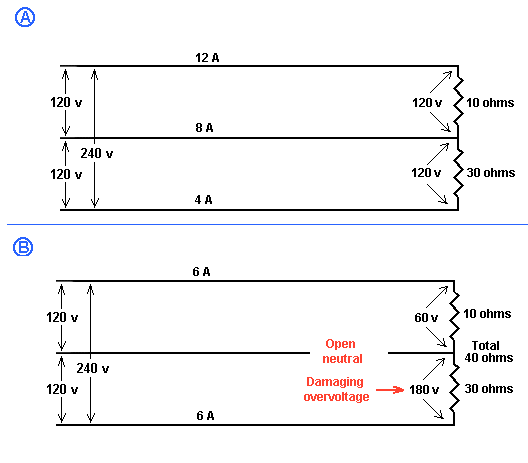JasonGSparky
Member
- Location
- St Petersburg, FL
So this may be a bit of a goofy question, but I was wondering if anyone knew of an easy way to explain how a lost service neutral can result in 240v on 120v circuits, some lights dimming while others get brighter, etc.
I've had a few service calls in last couple months where the home owner complains of the typical lost neutral problems - some devices started smoking, light bulbs burned out, other things aren't working; and aside from one mwbc that was knicked, its almost always the neutral from the power company was broken or corroded, resulting in these problems. (neat tip I learned, if the overhead service lines are hanging really low, its a good indication the neutral is busted off at the power line) I know how to troubleshoot it, I can usually find where the break is, and sometimes I can repair it myself if its on the house side.
The best explanation I can give to the customer is that, 120v circuits require the neutral wire to take the unbalanced load back to the transformer, and when that neutral is gone, the unbalanced voltage backfeeds the circuit. I'm not totally comfortable with this explanation, and I would like to know how this problem actually works. I've seen some diagrams and read other posts, but I just can't wrap my mind around it. I'm stuck on the fact that if both hots come in contact with each other or the neutral, something will trip or blow up, so how can you get 240v on a 120v outlet?:?
*My best thought is that when the service neutral is gone, all the voltages come back to the neutral bar and feed BACK through the other circuit neutrals. Still not sure how it doesn't trip a main breaker, unless the ground wire isn't adequate enough to cause a huge surge in current?
I've had a few service calls in last couple months where the home owner complains of the typical lost neutral problems - some devices started smoking, light bulbs burned out, other things aren't working; and aside from one mwbc that was knicked, its almost always the neutral from the power company was broken or corroded, resulting in these problems. (neat tip I learned, if the overhead service lines are hanging really low, its a good indication the neutral is busted off at the power line) I know how to troubleshoot it, I can usually find where the break is, and sometimes I can repair it myself if its on the house side.
The best explanation I can give to the customer is that, 120v circuits require the neutral wire to take the unbalanced load back to the transformer, and when that neutral is gone, the unbalanced voltage backfeeds the circuit. I'm not totally comfortable with this explanation, and I would like to know how this problem actually works. I've seen some diagrams and read other posts, but I just can't wrap my mind around it. I'm stuck on the fact that if both hots come in contact with each other or the neutral, something will trip or blow up, so how can you get 240v on a 120v outlet?:?
*My best thought is that when the service neutral is gone, all the voltages come back to the neutral bar and feed BACK through the other circuit neutrals. Still not sure how it doesn't trip a main breaker, unless the ground wire isn't adequate enough to cause a huge surge in current?



